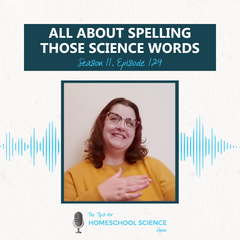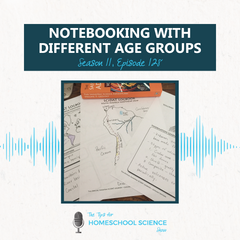FREE Shipping on all our products! (Please Note: Orders may experience a delay of a week or more in shipping due to the high volume of orders at this time of year.)
FREE Shipping on all our products! (Please Note: Orders may experience a delay of a week or more in shipping due to the high volume of orders at this time of year.)
What it looks like to use living books for science (Middle School) - Living Books Session, part 3 {Episode 40}
February 26, 2018 2 min read
What it looks like to use living books for science (Middle School) - Inspiring your students to love science through living books, Part 3 {Episode 40}
We have looked at what living books are, how to choose one, and what it looks like to use living books for science with our younger students. In this episode, we are going to wrap up the "Inspiring your students to love science through living books" session with a chat about what it looks like to use living books for science during the middle school years.
Hi, I’m Paige Hudson and you are listening to the Tips for Homeschool Science Show where we are breaking down the lofty concepts of science into building blocks you can use in your homeschool!
Listen to this episode
Share the Tips
If you found these homeschool science tips to be helpful, would you please take a moment to rate it on iTunes or Stitcher? This would help me tremendously in getting the word out so that more earbuds are filled with science-teaching encouragement.
Highlights

Basically, when you use living books for science with middle school students, you will:
- Read and enjoy
- Expect written work
- Add-in relevant non-fiction books
- Do Experiments
Goals for elementary science education are relatively simple.
- To begin to train the student’s brain to think analytically about the facts of science.
- To familiarize the student with the basics of the scientific method through inquiry-based methods.
- To continue to feed the student with information about the world around them.
When you are teaching science to middle school students, you want to include the following:
- Experiments – Experiment are more student-led than the demonstrations you used during the elementary years.
- Information – The students need a way to gather the facts they need to know. Again, living books with a science bent definitely fit the bill here!
- Writing – Basically, you want a way to record what the students are learning. This can take the form of summaries or outlines during these years.
- The Science Project – Middle school students should begin doing a yearly science fair project.
- Extras – If you want to give quizzes or tests, the middle school years are a good time to begin. You can also have the students do a bit of Internet research and related activities to round things out if they are seeking more.
A Sample Week for Middle School Students
- Day 1 – Living Books and Writing
- Day 2 – Living Books and Writing
- Day 3 – Experiment and Writing
- Day 4 and 5 - Add in some Optional Extras
Takeaway Tidbits
Middle school students are full of unorganized information from the elementary years. (Pin this Tidbit)
When you read living books with the older crowd your main focus is to feed them with important facts in a memorable way. (Pin this Tidbit)
Additional Resources
See the full conference session - Inspiring your students to love science through living books.
Check out the following articles for more tips on living books and middle school students:
Also in {Podcast} The Tips for Homeschool Science Show
All About Spelling Those Science Words {Season 11, Episode 129}
March 25, 2024 7 min read

In this episode, we'll be interviewing Robin Williams from All About Spelling. Click "Read More" to listen is as we discuss tips and tricks for spelling all those science words!
How should you handle notebooking through the different ages? {Season 11, Episode 128}
March 18, 2024 3 min read

Writing in Science with a Well-Trained Mind (Interview) {Season 11, Episode 127}
March 11, 2024 16 min read

Click "Read More" to listen in as Susan Wise Bauer and Susanna Jarret join Paige to share tips and tools about the third key to teaching science!
Subscribe
Sign up to get the latest on sales, new releases and more …


